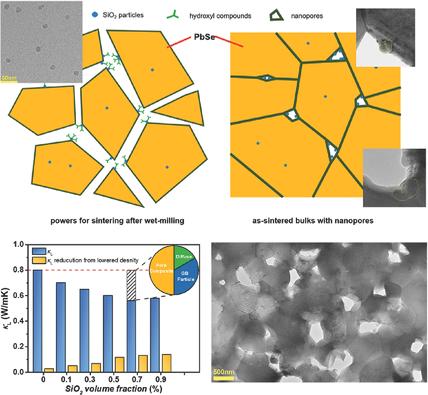Our official English website, www.x-mol.net, welcomes your
feedback! (Note: you will need to create a separate account there.)
Nanoporous PbSe–SiO2 Thermoelectric Composites
Advanced Science ( IF 14.3 ) Pub Date : 2017-08-11 , DOI: 10.1002/advs.201700199 Chao-Feng Wu 1 , Tian-Ran Wei 1 , Fu-Hua Sun 1 , Jing-Feng Li 1
Advanced Science ( IF 14.3 ) Pub Date : 2017-08-11 , DOI: 10.1002/advs.201700199 Chao-Feng Wu 1 , Tian-Ran Wei 1 , Fu-Hua Sun 1 , Jing-Feng Li 1
Affiliation

|
Nanoporous architecture has long been predicted theoretically for its proficiency in suppressing thermal conduction, but less concerned as a practical approach for better thermoelectric materials hitherto probably due to its technical challenges. This article demonstrates a study on nanoporous PbSe–SiO2 composites fabricated by a facile method of mechanical alloying assisted by subsequent wet‐milling and then spark plasma sintering. Owing to the formation of random nanopores and additional interface scattering, the lattice thermal conductivity is limited to a value as low as 0.56 W m−1 K−1 at above 600 K, almost the same low level achieved by introducing nanoscale precipitates. Besides, the room‐temperature electrical transport is found to be dominated by the grain‐boundary potential barrier scattering, whose effect fades away with increasing temperatures. Consequently, a maximum ZT of 1.15 at 823 K is achieved in the PbSe + 0.7 vol% SiO2 composition with >20% increase in average ZT, indicating the great potential of nanoporous structuring toward high thermoelectric conversion efficiency.
中文翻译:

纳米多孔PbSe–SiO2热电复合材料
长期以来,人们一直在预测纳米多孔体系结构具有抑制热传导的能力,但迄今为止,由于其技术挑战,作为一种更好的热电材料的实用方法,人们对其关注较少。本文展示了对纳米多孔PbSe-SiO 2复合材料的研究,该复合材料是通过机械合金化的简便方法制造的,该方法随后进行湿法研磨,然后进行电火花等离子烧结。由于无规纳米孔的形成和附加的界面散射,晶格热导率被限制在低至0.56 W m -1 K -1的值在高于600 K时,引入纳米级沉淀物几乎达到相同的低水平。此外,发现室温电传输受晶界势垒散射的控制,其影响随着温度的升高而消失。因此,在PbSe + 0.7 vol%的SiO 2组成中,在823 K处实现的最大ZT为1.15,平均ZT增加> 20%,这表明纳米孔结构具有向高热电转化效率发展的巨大潜力。
更新日期:2017-08-11
中文翻译:

纳米多孔PbSe–SiO2热电复合材料
长期以来,人们一直在预测纳米多孔体系结构具有抑制热传导的能力,但迄今为止,由于其技术挑战,作为一种更好的热电材料的实用方法,人们对其关注较少。本文展示了对纳米多孔PbSe-SiO 2复合材料的研究,该复合材料是通过机械合金化的简便方法制造的,该方法随后进行湿法研磨,然后进行电火花等离子烧结。由于无规纳米孔的形成和附加的界面散射,晶格热导率被限制在低至0.56 W m -1 K -1的值在高于600 K时,引入纳米级沉淀物几乎达到相同的低水平。此外,发现室温电传输受晶界势垒散射的控制,其影响随着温度的升高而消失。因此,在PbSe + 0.7 vol%的SiO 2组成中,在823 K处实现的最大ZT为1.15,平均ZT增加> 20%,这表明纳米孔结构具有向高热电转化效率发展的巨大潜力。











































 京公网安备 11010802027423号
京公网安备 11010802027423号